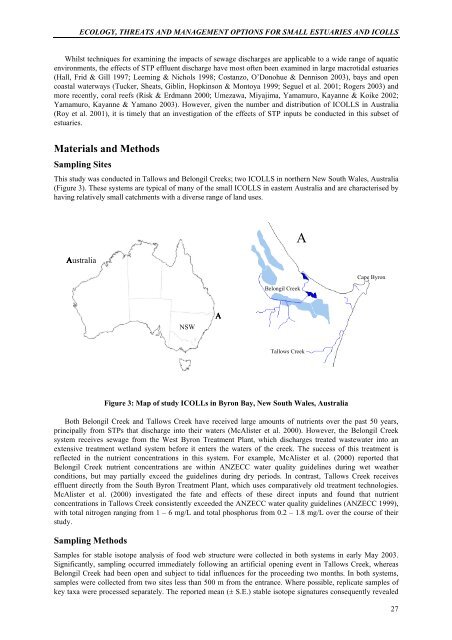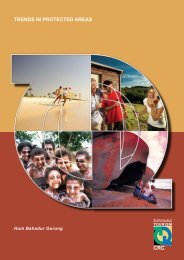icolls - Sustainable Tourism CRC
icolls - Sustainable Tourism CRC
icolls - Sustainable Tourism CRC
Create successful ePaper yourself
Turn your PDF publications into a flip-book with our unique Google optimized e-Paper software.
ECOLOGY, THREATS AND MANAGEMENT OPTIONS FOR SMALL ESTUARIES AND ICOLLS<br />
Whilst techniques for examining the impacts of sewage discharges are applicable to a wide range of aquatic<br />
environments, the effects of STP effluent discharge have most often been examined in large macrotidal estuaries<br />
(Hall, Frid & Gill 1997; Leeming & Nichols 1998; Costanzo, O’Donohue & Dennison 2003), bays and open<br />
coastal waterways (Tucker, Sheats, Giblin, Hopkinson & Montoya 1999; Seguel et al. 2001; Rogers 2003) and<br />
more recently, coral reefs (Risk & Erdmann 2000; Umezawa, Miyajima, Yamamuro, Kayanne & Koike 2002;<br />
Yamamuro, Kayanne & Yamano 2003). However, given the number and distribution of ICOLLS in Australia<br />
(Roy et al. 2001), it is timely that an investigation of the effects of STP inputs be conducted in this subset of<br />
estuaries.<br />
Materials and Methods<br />
Sampling Sites<br />
This study was conducted in Tallows and Belongil Creeks; two ICOLLS in northern New South Wales, Australia<br />
(Figure 3). These systems are typical of many of the small ICOLLS in eastern Australia and are characterised by<br />
having relatively small catchments with a diverse range of land uses.<br />
Australia<br />
Figure 3: Map of study ICOLLs in Byron Bay, New South Wales, Australia<br />
Both Belongil Creek and Tallows Creek have received large amounts of nutrients over the past 50 years,<br />
principally from STPs that discharge into their waters (McAlister et al. 2000). However, the Belongil Creek<br />
system receives sewage from the West Byron Treatment Plant, which discharges treated wastewater into an<br />
extensive treatment wetland system before it enters the waters of the creek. The success of this treatment is<br />
reflected in the nutrient concentrations in this system. For example, McAlister et al. (2000) reported that<br />
Belongil Creek nutrient concentrations are within ANZECC water quality guidelines during wet weather<br />
conditions, but may partially exceed the guidelines during dry periods. In contrast, Tallows Creek receives<br />
effluent directly from the South Byron Treatment Plant, which uses comparatively old treatment technologies.<br />
McAlister et al. (2000) investigated the fate and effects of these direct inputs and found that nutrient<br />
concentrations in Tallows Creek consistently exceeded the ANZECC water quality guidelines (ANZECC 1999),<br />
with total nitrogen ranging from 1 – 6 mg/L and total phosphorus from 0.2 – 1.8 mg/L over the course of their<br />
study.<br />
Sampling Methods<br />
NSW<br />
A<br />
Samples for stable isotope analysis of food web structure were collected in both systems in early May 2003.<br />
Significantly, sampling occurred immediately following an artificial opening event in Tallows Creek, whereas<br />
Belongil Creek had been open and subject to tidal influences for the proceeding two months. In both systems,<br />
samples were collected from two sites less than 500 m from the entrance. Where possible, replicate samples of<br />
key taxa were processed separately. The reported mean (± S.E.) stable isotope signatures consequently revealed<br />
A<br />
Belongil Creek<br />
Tallows Creek<br />
Taylor’s Lagoon<br />
Cape Byron<br />
27











